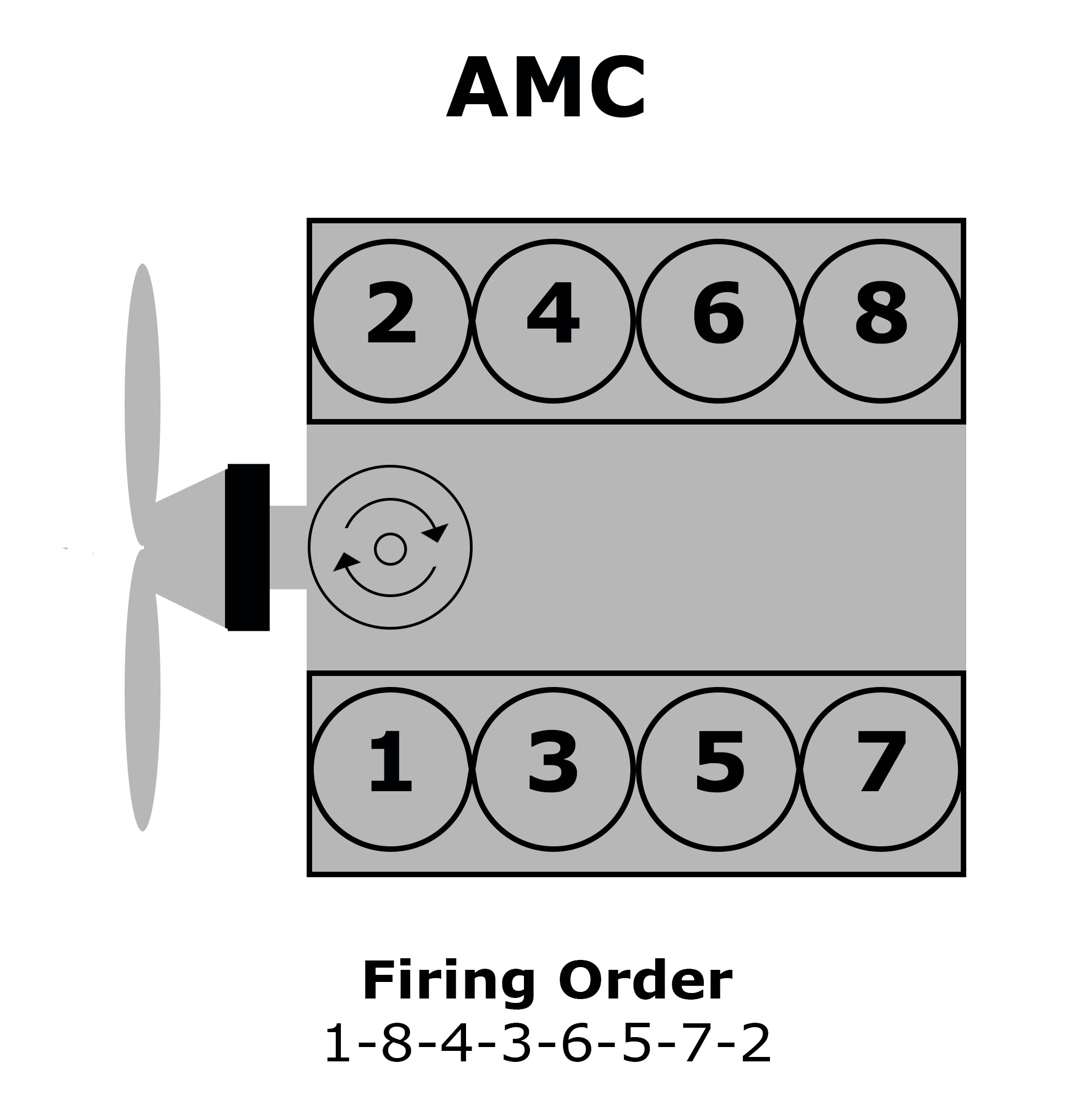The AMC 304 V8 engine, part of the American Motors Corporation (AMC) V8 family, is renowned for its rugged reliability and versatility. Found in vehicles like the Jeep CJ and AMC muscle cars, this engine relies on a precise firing order to ensure smooth operation and optimal performance.
In this guide, we’ll break down the AMC 304 firing order, explain how it works, and highlight its importance.

Quick Navigation
What is a Firing Order?
The firing order refers to the sequence in which the engine’s cylinders ignite their air-fuel mixture. This sequence ensures the engine runs smoothly, provides balanced power delivery, and minimizes vibrations. For the AMC 304, the firing order is 1-8-4-3-6-5-7-2.

This specific firing order is designed to complement the engine’s V8 configuration, optimizing efficiency, power output, and durability. Let’s explore how this firing order operates and why it matters.
Why the Firing Order Matters
The firing order is a critical aspect of engine functionality. Here are the key reasons why it’s essential:
- Engine Balance: The correct firing order ensures the engine remains balanced, reducing vibrations and stress on components.
- Power Delivery: A proper sequence allows for consistent torque output, improving throttle response and acceleration.
- Efficiency: Correct firing ensures complete combustion, optimizing fuel economy and minimizing emissions.
- Longevity: Balanced firing reduces wear and tear on engine components, enhancing durability.
- Smooth Operation: The firing order prevents misfires and ensures smooth idling and driving performance.
An incorrect firing order can cause misfires, rough running, and even long-term engine damage.
The AMC 304 Firing Order: 1-8-4-3-6-5-7-2
The AMC 304’s firing order, 1-8-4-3-6-5-7-2, is tailored to the V8 engine layout. Here’s a step-by-step explanation of how this sequence works:
- Cylinder 1 Fires: The sequence begins with Cylinder 1, where the spark plug ignites the air-fuel mixture during the power stroke.
- Cylinder 8 Follows: Cylinder 8 fires next, maintaining smooth power delivery.
- Cylinder 4 Engages: Cylinder 4 fires, contributing to the engine’s balance.
- Cylinder 3 Ignites: Cylinder 3 takes over, continuing the firing sequence.
- Cylinder 6 Fires: Cylinder 6 ignites next, ensuring consistent operation.
- Cylinder 5 Engages: Cylinder 5 fires, maintaining the cycle’s momentum.
- Cylinder 7 Fires: Cylinder 7 takes its turn in the sequence, balancing power output.
- Cylinder 2 Completes the Cycle: Finally, Cylinder 2 fires, and the sequence repeats.
This firing order ensures that power strokes are evenly spaced, which is critical for the V8 engine’s balance and efficiency.
How the Firing Order Works in the AMC 304
The AMC 304 operates on a four-stroke cycle, which includes the following stages:
- Intake Stroke: The air-fuel mixture enters the cylinder as the intake valve opens.
- Compression Stroke: The piston compresses the mixture, preparing it for ignition.
- Power Stroke: The spark plug ignites the mixture, driving the piston downward and generating power.
- Exhaust Stroke: The exhaust valve opens, expelling the spent gases.
The firing order coordinates these strokes across all eight cylinders, ensuring smooth and continuous power delivery. The 1-8-4-3-6-5-7-2 sequence is specifically designed to optimize the balance and performance of the AMC 304 engine.
Key Components Supporting the Firing Order
Several components are essential to maintaining the AMC 304’s firing order. Each part plays a specific role in ensuring the engine operates correctly:
- Crankshaft: Converts the pistons’ reciprocating motion into rotational energy, driving the sequence of power strokes.
- Camshaft: Controls the opening and closing of the intake and exhaust valves, synchronizing them with the firing order.
- Distributor: Directs electrical signals to the spark plugs in the correct sequence, ensuring proper ignition timing.
- Spark Plugs: Ignite the air-fuel mixture in each cylinder at precisely the right moment.
- Timing Chain/Belt: Synchronizes the crankshaft and camshaft to maintain the firing order.
When these components function in harmony, the engine executes its firing order seamlessly, delivering reliable and efficient performance.
Symptoms of Firing Order Issues
Disruptions in the firing order can lead to noticeable engine problems. Common symptoms include:
- Engine Misfires: Cylinders fail to ignite properly, causing uneven power delivery.
- Rough Idling: The engine may vibrate excessively or run inconsistently at idle.
- Power Loss: An incorrect firing order reduces efficiency, leading to sluggish acceleration.
- Backfiring: Faulty timing can cause combustion gases to ignite in the intake or exhaust system.
- Excessive Vibrations: Imbalanced firing creates noticeable engine vibrations.
Identifying and addressing these issues promptly is crucial to prevent further damage.
How to Verify the Firing Order
To confirm that the AMC 304’s firing order is correct, follow these steps:
- Inspect the Spark Plug Wires: Verify that each wire is connected to the correct cylinder and distributor terminal according to the firing order.
- Check the Distributor Cap: Ensure the cap is in good condition and the terminals align with the firing sequence.
- Use a Timing Light: A timing light can help confirm that each spark plug fires at the appropriate moment.
- Consult the Service Manual: Refer to the AMC 304 service manual for the correct firing order and wiring diagram.
- Listen for Irregular Sounds: Unusual noises, such as knocking or sputtering, may indicate a firing order problem.
Regular inspections can help maintain the correct firing order and ensure the engine runs smoothly.
Maintaining the Firing Order
Proper maintenance is key to preserving the AMC 304’s firing order and ensuring the engine operates at peak performance. Here are some practical tips:
- Replace Spark Plugs: Worn spark plugs can cause misfires and disrupt the firing sequence.
- Inspect the Ignition System: Check the distributor, ignition coil, and spark plug wires for damage or wear.
- Monitor the Timing Chain/Belt: Ensure the timing mechanism is properly aligned and tensioned to avoid firing order disruptions.
- Perform Routine Tune-Ups: Regular inspections and adjustments help identify potential issues early.
- Use High-Quality Fuel: Clean-burning fuel reduces carbon buildup, promoting efficient combustion.
Following these practices will keep your AMC 304 running smoothly and efficiently.
Can You Modify the Firing Order?
The AMC 304’s firing order, 1-8-4-3-6-5-7-2, is specifically designed for the engine’s V8 configuration. Modifying the firing order is not recommended because it can:
- Imbalance the Engine: Altering the sequence can lead to excessive vibrations and instability.
- Reduce Efficiency: Incorrect firing disrupts combustion, causing power loss and increased fuel consumption.
- Damage Components: Changing the firing order can place undue stress on the engine, leading to long-term damage.
Instead of modifying the firing order, focus on upgrades such as tuning the ignition system, optimizing the intake and exhaust, or refining the ECU for better performance.
Conclusion
The AMC 304’s firing order, 1-8-4-3-6-5-7-2, is a fundamental aspect of its V8 engine design. This precise sequence ensures balanced operation, smooth power delivery, and efficient combustion. Understanding how the firing order works and maintaining it properly is crucial for keeping the engine reliable and performing at its best.
With regular maintenance, attention to detail, and early diagnostics, you can preserve the firing order and enjoy the dependable performance of the AMC 304 engine. Whether you’re restoring a classic AMC vehicle or maintaining your Jeep, following this guide will help you maximize the potential of your AMC 304-powered vehicle.

